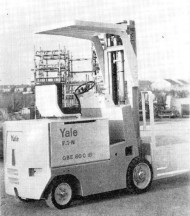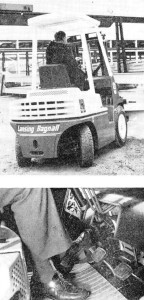 Welcome to episode fiftyeight in our exclusive series on the history of the fork lift truck, the machine which over the decades has revolutionised the face of materials handling around the world. In this episode we’re up to 1972, the year of the Watergate Hotel break in, which led to President Nixon’s impeachment, and in our industry the formation of the Forklift Hire Industry Technical Association, the predecessor of the present Fork Lift Truck Association.
Welcome to episode fiftyeight in our exclusive series on the history of the fork lift truck, the machine which over the decades has revolutionised the face of materials handling around the world. In this episode we’re up to 1972, the year of the Watergate Hotel break in, which led to President Nixon’s impeachment, and in our industry the formation of the Forklift Hire Industry Technical Association, the predecessor of the present Fork Lift Truck Association.
Our writer is James Brindley, an acknowledged authority on fork lift trucks. James’s distinguished career has involved engineering and management roles with BT Rolatruc and serving as a Director of the FLTA, before he set up the National Fork Truck Heritage Centre in 2004 as Britain’s first such collection open to the public.
The Heritage Centre continues to need your support in 2011, and if you or your company would like to help in any way, you can contact James on the number below. Now sit back and enjoy the latest part of this fascinating series.
Episode 58: 1972 – Watergate Hotel burgled: seed sown for FLTA
Many of the new exhibits at the 1972 International Exhibition seemed to concentrate more on machine trim and safety than on technical innovation. This was certainly the view of the majority of companies who produced battery electric equipment. Finding it difficult to improve on an already advanced standard of technical sophistication, their main thrust was towards the comfort of the driver and to make the machine look more attractive so that the operator would take pride and look after it better.
Two such manufacturers were Lansing Bagnall, who produced their FOER 12 range, and Yale with its GBE range. The FOER 12 range was made available in six models with lift capacities from 1,500 lbs to 3,000 lbs, three with a 39-inch wheelbase and three with a 45-inch wheelbase. A great number of common parts were used between these models to rationalise production and to make them easier to maintain. Standard fittings to the trucks included overhead guards, which incorporated a hinged gate for easier battery removal by sling from above, shock absorbing driver seats and easily adjusted forks. The optional extras included lighting kits for turning indicators, stoplights and hazard lights and devices for signalling fork overload and mast tilt. From America the initial launch of three trucks from the Yale GBE range, giving 4,000 lb, 5,000 lb and 6,000lb capacities, were all fitted with Yale’s Econtrol system giving speeds of up to 7.8 mph laden. Offered as standard with the trucks was equipment that would normally be considered as extras.
These included a load backrest, overhead guard, discharge battery indicator, power steering and a padded driver’s seat.
 On the diesel front Lansing Bagnall unveiled their long awaited entrant into the IC world with their model FODR 5. With lifting capacities of 4,000 lbs, 5,000 lbs and 6,000 lbs and powered by the reliable Perkins 4203 engine, the well styled truck had above average speed and acceleration and was easy to drive and manoeuvre. Powered steering was fitted as standard and the machine’s transmission was by hydroelectric torque converter fitted directly between engine and drive axle. In step with the Company’s new battery powered range, it seems that driver consideration and truck performance was paramount. This was shown by the longer and wider measurements of the machine compared to most of their competitors’ trucks. Added to this was a new style cab layout which used a pedal arrangement similar to an automobile, with accelerator and brakes operated by the right foot and a combined inching pedal with brakes by the left. In driver terms, not only was the machine more spacious and comfortable, it gave travel speeds up to 14 mph. Together with a wider turning circle and average lift heights without deration, it certainly looked as if the designers also had a win with an almost perfect truck for intensive outside working.
On the diesel front Lansing Bagnall unveiled their long awaited entrant into the IC world with their model FODR 5. With lifting capacities of 4,000 lbs, 5,000 lbs and 6,000 lbs and powered by the reliable Perkins 4203 engine, the well styled truck had above average speed and acceleration and was easy to drive and manoeuvre. Powered steering was fitted as standard and the machine’s transmission was by hydroelectric torque converter fitted directly between engine and drive axle. In step with the Company’s new battery powered range, it seems that driver consideration and truck performance was paramount. This was shown by the longer and wider measurements of the machine compared to most of their competitors’ trucks. Added to this was a new style cab layout which used a pedal arrangement similar to an automobile, with accelerator and brakes operated by the right foot and a combined inching pedal with brakes by the left. In driver terms, not only was the machine more spacious and comfortable, it gave travel speeds up to 14 mph. Together with a wider turning circle and average lift heights without deration, it certainly looked as if the designers also had a win with an almost perfect truck for intensive outside working.
Also at the 1972 show, the seed was sown for the foundation of the Fork Truck Hire Association. Tentatively named the Forklift Hire Industry Technical Association, it was to represent both the forklift hire companies and the forklift manufacturers who had subsidiaries engaged in the hire business. From this small nucleus the membership has since grown to represent companies throughout the UK. In the present year of 2011 the organisation, now known as the Fork Lift Truck Association, represents well over 200 forklift truck companies and also supports over 150 end users in its Safe User group membership.
By James Brindley, Director, National Fork Truck Heritage Centre
To be continued
National Fork Truck Heritage Centre
James Brindley
Tel: 0780 195 4167




Comments are closed.